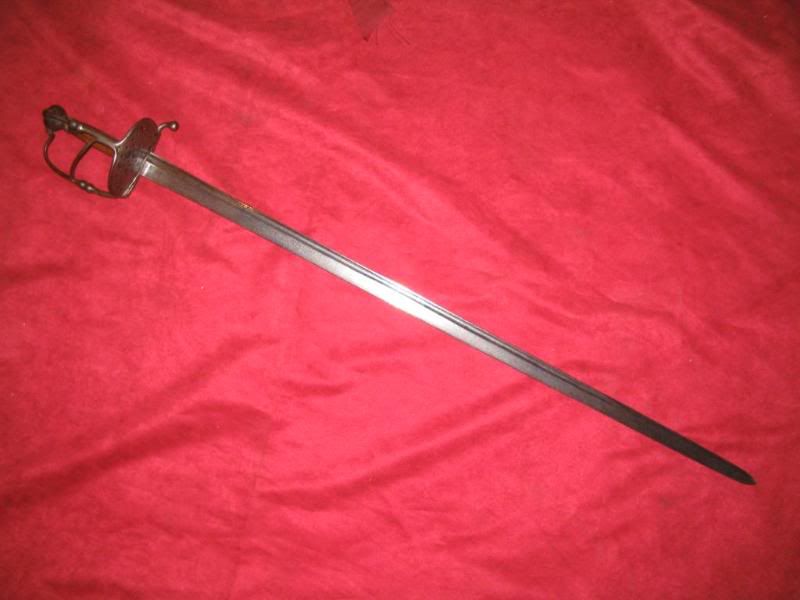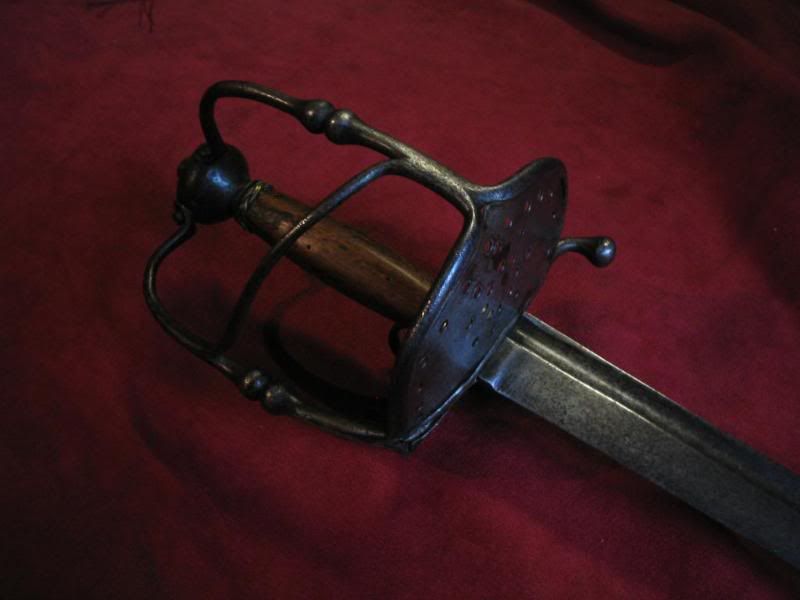
 |
|
|
#1 |
|
(deceased)
Join Date: Dec 2004
Location: Portugal
Posts: 9,694
|
This piece is on its way to my little collection.
Said to be German, dated around 1700. Blade length 91, 5 cms Width 38 mm There are some numbers and letters marked on the pommel - LCR N118 - said to be regimental markings. I would like to know your opinnion on this sword, namely on its age, country of origin and, if possible, an idea of the markings provenance. Thanks a lot in advance. Fernando . |
|
|

|
|
|
#2 |
|
Arms Historian
Join Date: Dec 2004
Location: Route 66
Posts: 10,680
|
Very, very nice Fernando!!
These very businesslike military swords have always been most appealing to me, and I was always intrigued by the curious term for them. According to Neumann, "Swords and Blades of the American Revolution", pp.156,157) these bilobate counterguard horsemans swords seem to have originated in the Low Countries around the first part of the 17th century, and gained popularity across Europe. The term 'walloon' refers to the people of Wallonia (fr.=wall), which is a region in Belgium, and it seems likely became colloquially used , probably by the French, for this type of sword. In Wagner ("Cut and Thrust Weapons", 1967, p.372) there is an Austrian cavalry example nearly identical to yours, shown as the beginning of the 18th century. I cannot recall offhand the case with the prominant screws holding the elements of the guard to the pommel, but this seems also a very early feature, and the rebated, rounded point of the blade is most interesting. It seems these type blades are seen on German swords of this period. I am not sure on the markings, and they same inscribed later, on the pommel seems unusual. All best regards, Jim Last edited by Jim McDougall; 4th November 2008 at 02:41 AM. |
|
|

|
|
|
#3 |
|
Member
Join Date: Dec 2004
Location: NC, U.S.A.
Posts: 2,207
|
Awesome sword, Fernando! (green with envy, green with envy! _Did I think that aloud!). The rounded tip is just like that found on one of my swords (the Spanish bilbo). I had assumed the tip had broke & been reshaped or that it had lost its point from over-sharpening.
Jim, did I understand you correctly that some of the older swords with slightly rounded points were a common pattern in German swords? As said above, I've seen this in some Spanish pieces as well (probably imported blades, I imagine?). thanks, Mark |
|
|

|
|
|
#4 |
|
Arms Historian
Join Date: Dec 2004
Location: Route 66
Posts: 10,680
|
Hi Mark,
I wouldnt say it was particularly common, but I have seen this rounded tip feature on a number of German 17th century blades, one with Spanish markings mounted on a Scottish baskethilt mounted c.1680. I have seen the same tip on German blades with Spanish markings found on Hungarian sword of same period. To me it has always seem interesting that the blades on Omani kattara are invariably with rounded point, as are Tuareg takoubas, both known for receiving German trade broadsword blades. It would be interesting to check on resources to see how many instances do reveal this rounded tip, and how often they occur on German trade blades. All the best, Jim |
|
|

|
|
|
#5 |
|
Member
Join Date: Sep 2008
Location: PR, USA
Posts: 679
|
Darn It! Your walloon is prettier than mine...
    QUOTE=fernando]This piece is on its way to my little collection. Said to be German, dated around 1700. Blade length 91, 5 cms Width 38 mm There are some numbers and letters marked on the pommel - LCR N118 - said to be regimental markings. I would like to know your opinnion on this sword, namely on its age, country of origin and, if possible, an idea of the markings provenance. Thanks a lot in advance. Fernando |
|
|

|
|
|
#6 |
|
Member
Join Date: Feb 2008
Location: Edinburgh, Scotland
Posts: 48
|
Hi Folks,
The Walloon is very similar to one that I have recently restored. It forms part of the armoury collection of Kelly Castle in Scotland, which I have for restoration at the moment.  
|
|
|

|
|
|
#7 |
|
Member
Join Date: Jun 2008
Location: The Sharp end
Posts: 2,928
|
Congratulations Fernando!!!
What a lovely example, I've always wanted one of these! I am very envious, I don't think you could have hoped to find a better one. Manuel! Extremely fine sword there as well! *sigh* So many beautiful swords in the world that I don't own! 
|
|
|

|
|
|
#8 |
|
Member
Join Date: May 2010
Posts: 20
|
Very nice swords!
I recently purchased this: Last edited by fernando; 11th July 2011 at 01:04 PM. Reason: Pictures direct upload |
|
|

|
|
|
#9 |
|
Member
Join Date: Dec 2004
Location: NC, U.S.A.
Posts: 2,207
|
Very nice sword, Carl! I particularly like the grotesque staring face on the guard. Is this reminescent of the so-called mourning swords portraying the "death's Head" of King Louis? These types date to the English Civil War period, contemporary with your walloon. Great find!!
|
|
|

|
|
|
#10 |
|
(deceased)
Join Date: Sep 2008
Location: Bavaria, Germany - the center of 15th and 16th century gunmaking
Posts: 4,310
|
Hi 'Nando,
I too have to join in the multifold praise of your sword though strictly speaking it is not of Walloon type but a normal field sword for cuirassiers and dragoons. From what I have learned, a date of ca. 1700 would seem exactly correct as the use of screws on the hilt denotes, as well as the rather small knots. These do not occur on earlier types of swords. It possibly is of German (Solingen) manufacture, and the numbering and initials relate to the bearer und regimental number. This type was in use almost over Europe, including Spain. The other nice Walloons illustrated here I would assign to the 1640s to 1660s. Best, Michl Last edited by Matchlock; 21st July 2011 at 04:09 PM. |
|
|

|
|
|
#11 |
|
(deceased)
Join Date: Dec 2004
Location: Portugal
Posts: 9,694
|
Thank you so much for your input and pictures Michl.
You will notice that, it has been almost two years since i posted this sword. In the meantime i have learned a bit more about it, namely on the typology side. It seems as the Walloon term has been used (and abused) to define the swords within a detemined area of characteristics. Such is the case of my example; having bought it as being a Wallon sword, i later learned that it is in fact, as you well alert, a Dragoon sword ... although, i repeat, it falls within the Walloon range in several sources. As for its country of origin, that is indeed my actual concern. Certainly the (regimental) marks in the pommel would bring some light to it but, so far, no one has yet identified them. Worthy of note is what seems to be the signature of its ownner/user in one of its guard branches. . |
|
|

|
|
|
#12 |
|
Member
Join Date: Jul 2009
Location: Nipmuc USA
Posts: 535
|
Green plus three here to see these in other hands. I am wondering about this pair attached below. Obviously later than the Walloons but seem in kind to some other early 18th century pallasch. The swords were espied in the Haddon Hall in Derbyshire. A bit of looking about shows Haddon Hall pretty much redone and any association might be pretty vague but one thought was that they were late 18th century heavy cavalry dress swords. While the 1796 dress might somewhat resemble these, I couldn't agree and was figuring they must be a good bit earlier.
I am afraid I am probably and terminally stuck pursuing early Americana but the Walloons and later pallasch somehow seem to be part of the natural progressions of straight cavalry swords. Cheers GC |
|
|

|
|
|
#13 |
|
Arms Historian
Join Date: Dec 2004
Location: Route 66
Posts: 10,680
|
In reading this thread I became interested in what really the term 'walloon' is all about. Apparantly it is with reference to French speaking people in the south and southeast of Belgium, and parts of France. In the early 17th century many of these people emigrated to Sweden including many if not most involved in metalwork or various parts if iron producing. As many of these were from Liege, they were part of the advent of Swedish arms production as well.
The walloon military swords seem characterized primarily by the bilobate guard which is pierced with a star surrounded by eight holes in overall pattern as well as a knucklebow usually with expanded center section. As these simple hilt military swords became more well known, more developed hilts seem to have evolved in Germany and many of the Continental principalities, with these typically being termed 'feldeggen' or veldeggen or variations thereof, essentially 'battle swords'. The thumb ring seen on walloons seems also integral in these more developed guards on these hilts. The French on campaign in Netherlands 1672-73 captured many of these swords, by then produced not only in Sweden but by Germany for the Dutch, and adopted the style for thier own regulation pattern swords. Apparantly from what I have seen, the French patterns pierced bilobate plates are usually convex. It is unclear when the walloon term came into being, but seems to be with 19th century collectors as is often the case. It is worthy of note that the German made examples of walloons often have the famed running wolf, along with the spurious SAHAGUM name in the fullers. This German adoption of the famed Spanish swordsmiths name is naturally often in varied spelling, but seems more prevalent in swords exported to these regions. Many of the blades to Dutch walloons have Amsterdam city control marks at forte, and often with three petaled flower on the quillon terminal or the four petal kleeblatt (clover). The markings on the pommel are as noted likely regimental, and German and Dutch units were usually designated by colonels name, the LC perhaps initials from a name with C for cavalry, the R of course regiment. No. 118 of course likely rack number, but may be other. It would be interesting to see other examples of such unit markings on other pommels.....anybody have any they might post? |
|
|

|
 |
|
|